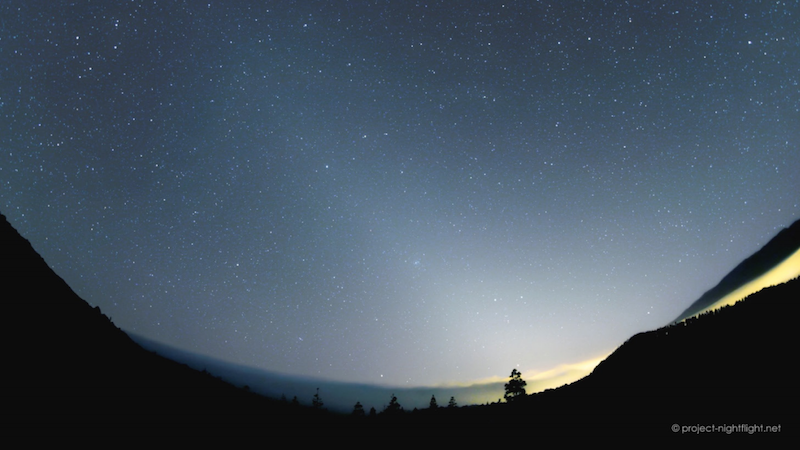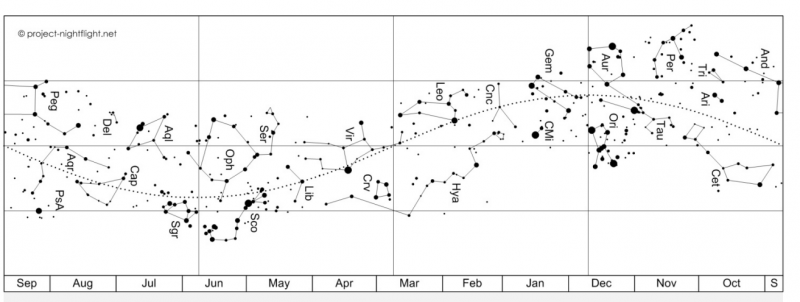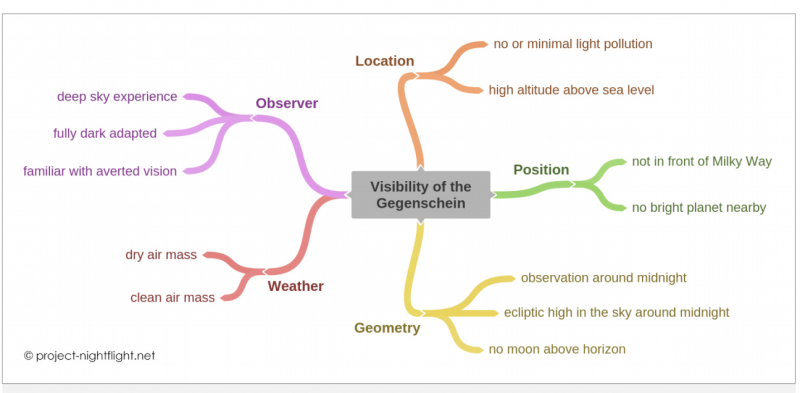
The sun’s counterglow – or gegenschein – is a stargazers’ holy grail. Every amateur astronomer has heard of it. But only a few of them have ever seen it. And fewer still have captured an image of this dim and ghostlike apparition. As a fellow observer put it:
The gegenschein is certainly not a GoTo object.
Matter of fact, it isn’t an object at all. But let’s start from the beginning.
What is the gegenschein?
The space between the planets isn’t empty. The plane of the solar system is filled with an enormous disk of small dust particles with sizes ranging from less than 1/1000 of a millimeter up to 1 millimeter. This interplanetary dust cloud is a highly dynamic structure. In contrast to conventional wisdom, it is not an eons-old leftover from the solar system’s formation. That primordial dust is long gone. Today’s interplanetary dust is – in an astronomical sense – very young, only millions of years old. Most of the particles originate from quite recent incidents, like asteroid collisions.
Exposed to various forces, the particles do not remain in stationary orbits but inhabit the disk in ever-changing motion. The smallest particles (less than 1/1000 of a millimeter) are swiftly blown out of the solar system by the solar wind. The larger particles don’t survive long either. They tend to collide with larger bodies or slowly spiral into the inner solar system where they fall into the sun.
Nevertheless, asteroid collisions and the erosion of comets constantly replenish the supply of interplanetary dust. So, the interplanetary dust cloud of the solar system is not a static formation but a dynamic structure consisting of quite young components.
Zodiacal light and gegenschein
For an observer on Earth, this dynamic dust cloud is mainly visible in the form of the zodiacal light. After dusk and before dawn it extends as a cone of light from the sun along the ecliptic path. Often called the false dawn, the zodiacal light is quite bright and can be seen from any observing site that doesn’t suffer from severe light pollution, especially when the ecliptic is high in the sky. For Northern Hemisphere observers, this is the case in the evening sky during spring and in the morning sky during autumn.
Interestingly, recent research suggests that the zodiacal light may be from Martian dust storms.
The morning and evening zodiacal light are the two areas of the interplanetary dust disk where sunlight gets forward scattered to earth, resulting in the bright silvery light cones. The interplanetary dust disk is also visible along the rest of the ecliptic path, where it is known as the zodiacal band. Unlike the zodiacal light, however, these sections are very hard to detect since they have an extremely low surface brightness. But at the point directly opposite the sun the geometry again works in our favor and enhances the visibility of the interplanetary dust. This is the area of the gegenschein.

Brighter when opposite the sun
But why does the gegenschein glow brighter than the rest of the zodiacal band? Looking at the interplanetary dust disk from Earth, the section at the antisolar point is illuminated from directly behind our heads. This results in an increase in brightness called the opposition effect. The opposition effect is a frequent phenomenon for solar system bodies. For example, the moon shows a significant peak in brightness around full moon, i.e. at its opposition. Another example is Saturn’s rings in the days around opposition, when they brighten drastically.
You may have also seen this effect when on an airplane. Read more: How can you see an airplane glory?
The gegenschein effect on Earth
The main reason for this brightening during opposition is shadow hiding, meaning that all particles are fully illuminated. You can see this opposition effect here on Earth during daylight if you’re outdoors and look at the ground in front of you. If the ground is sufficiently coarse, you’ll see a brightening around the shadow of your head. To document this phenomenon, we made the photo below, which shows the effect on volcanic gravel.

Interestingly, the brightening around the camera’s shadow had an apparent diameter of 10 degrees, about the same size as the diameter of the gegenschein in the night sky. Next time you walk on a rough surface in sunlight, look for this terrestrial version of the counterglow.
To sum up, the gegenschein is not an object. It’s a play of light on the solar system’s interplanetary dust disk. The section of the dust at the antisolar point is squarely illuminated, resulting in a brightness enhancement due to shadow hiding. This so-called opposition effect can be encountered at many occasions, but with the gegenschein it makes its most ghostlike and outlandish appearance. This is probably the reason why it is such a prized trophy among amateur astronomers.
Gegenschein under dark skies
From our observing and photography sessions at dark-sky sites, the gegenschein was a familiar companion. Out under the stars, sooner or later one of us would mention:
Hmm, the gegenschein is quite obvious tonight…
… followed by the typical reply:
Yep, bright and shiny!
This short dialogue would indicate that our eyes had reached full dark adaptation and our night vision was at maximum capacity. We often talked about making an image of our good old dark-sky companion, the gegenschein. But for some reason it never came to it. Other projects were in the way, on other occasions the position in the sky was not right, or the atmosphere’s transparency was just not good enough.
How we captured the gegenschein
But on the night from October 30 to 31, 2019, we finally did give it a go. On October 30 we were already several days on an imaging excursion on La Palma island. During daytime the annoying Calima weather pattern had finally stopped and skies were again as deep blue and transparent as they can be on this beautiful island. Accommodated in a solitary finca far away from inhabited areas and about 800 meters (2,600 feet) above sea level, we had the perfect conditions for photographing the gegenschein.
Around midnight, when the counterglow culminates, our instruments registered a sky brightness of 21.4 magnitudes per square arcsecond in the zenith. This is so dark that Sirius noticeably brightened the landscape when it rose behind a mountain ridge later that night.
The gegenschein itself was pretty obvious to the unaided eye. Below the constellation Aries, directly on the ecliptic path, a distinct glow about 10 degrees across marked the antisolar point. The very faint zodiacal band crossing the whole sky was visible too, almost looking like an artificial marking of the ecliptic. Under these conditions, shooting the gegenschein was an easy task.
Details, details
For those interested in the technical details: We made 23 unfiltered exposures of 4 minutes with a 16mm lens @f/5.6 on a Baader-modified 1100D Canon DSLR. For sky tracking we used a purely mechanical device, the Mini Track LX2. This innovative device is a frequent companion on our imaging excursions. For those interested in more details, we provide a thorough review of the Mini Track LX2 for download on our website.
The total weight of our imaging gear was less than 3 kilograms (6.6 pounds), including camera and tripod. The 23 individual exposures of the gegenschein were later calibrated, registered and stacked with DeepSkyStacker. Processing of the final image was done in Photoshop, where we applied substantial contrast enhancement.
How you can see the gegenschein
If you’ve never encountered the gegenschein yourself, don’t expect it to be as prominent as in the photograph at the top of this post. We applied heavy contrast enhancement to the image to make the counterglow, its shape and its size better visible. To our human eyes, even under the best conditions, the gegenschein is an elusive and dim glow.
On several occasions we compared the visual brightness of the counterglow and sections of the Milky Way. We always found it to be about as bright as the dimmest parts of the winter Milky Way. The stretch of the Milky Way that approximates the counterglow’s brightness best is the section between the star Mirfak and the asterism called the Kids next to Capella. That’s very dim. Any bright object in its vicinity (e.g. Jupiter or Mars at opposition) makes it hard to observe.
Aside from being slightly brighter in the middle and fading out uniformly in all directions, the gegenschein shows no structure at all. It has a roundish form, circular or elliptical, measuring approximately 10 degrees across. That is about the size of a fist stretched out at arm’s length.

Follow these 5 tips to see the gegenschein for yourself.
Tip 1: Check the position
Before you begin searching for the gegenschein in the night sky, you should check its current position. The map below helps you know where to look. It also shows you whether the counterglow is detectable at all, because its visibility highly depends on its position against the starry background.
In June, July and December it is completely invisible, because it is in front of the Milky Way. Other obstacles can be the bright planets Mars and Jupiter. When one of them is near opposition, it is in the same region of the sky as the counterglow and may outshine it.
Some planetarium programs or stargazing apps might also be useful tools to determine the position of the gegenschein. If the software provides an option to display the center of Earth’s shadow, this will show you the current antisolar point.

Tip 2: Look for it at maximum height above the horizon
The gegenschein is always highest above the horizon around local midnight, so that’s the best time of the night to give an observation a try. There should also be no moon above the horizon. But that’s not all. Like the sun itself, the antisolar point too has different culmination heights during the course of the year.
For observers in the Northern Hemisphere, the antisolar point has its highest culmination at the winter solstice around December 21. Sadly, during December the gegenschein is in front of the winter Milky Way and therefore invisible. So, the best months to see the gegenschein from northern latitudes are November and January.
For Southern Hemisphere observers, the largest culmination height of the antisolar point happens at summer solstice around June 21. For southerners too, the Milky Way is in the way. Again, one should look before or after the solstice, in this case during May or August.

Tip 3: Try from the best observing location you have access to
You can’t see the gegenschein from light-polluted sites. Even moderate light pollution diminishes the counterglow’s contrast too much. Based on our observations, the absolute minimum to detect the gegenschein is a sky brightness of 21.0 mag/arcsecond2 in the zenith. But this applies only if you are already quite familiar with the gegenschein and know exactly where to look.
For first-time observers, we recommend a site with a sky brightness of 21.2 mag/arcsecond2 in the zenith or better. These conditions only exist far from cities or other inhabited areas. Observing sites in the mountains especially qualify because of the reduced air mass at higher altitudes above sea level. (Click here to find a dark-sky site near you.)
Tip 4: Wait for favorable weather conditions
Even if you observe from a dark-sky location, the average clear sky might not be good enough for seeing the gegenschein. What you really want is a night sky with exceptionally high transparency. This will only be the case if the air mass above your observing site is as dry as possible.
To get an idea of the current situation at your location, you can use a website that provides weather forecasts for astronomical observations (e.g. 7timer.info). Sites like this display data about humidity at all tropospheric layers. Another condition for high transparency would be that the air is clean, i.e. free of dust. At mid-latitudes, the necessary conditions of dry and clean air often occur after the passage of a cold front or a trough.
Tip 5: Expand your observing skills
Given you have good eyesight in the dark and that you already have some observing experience, there are several observing techniques you need to master.
First, you need to learn how to become truly dark adapted. This might put your patience to a test, since your eyes need at least 3/4 of an hour to fully adjust to the dark. So, no smartphones or other handheld devices during this time. You should only use very dim red lights if you don’t want to ruin your night vision.
A second technique you might need for seeing the gegenschein is averted vision. With averted vision, you do not look directly at an object but a little off to the side while continuing to concentrate on the object. This way you are using peripheral vision, which is more sensitive to low light levels than the center of the eye. Some observers report that this technique makes a big difference for them, and it might help you too. In any case, hunting down the gegenschein will improve your observing skills a lot. Besides, it makes a highly interesting project and sooner or later you, too, will be able to put that prized stargazer’s trophy on your shelf.
What is Project Nightflight?
About Project Nightflight: “Our mission is the starry sky. We internationally promote the conservation of the starry sky as environmental resource. To support this goal, we work together closely with our sponsors and international news media. With our images and stories, we raise awareness for the need to keep light pollution at bay. Our team is based in Vienna, Austria, and consists of experienced, world-wide active astrophotographers who work on a volunteer basis. Most of our active members are marketing or communication professionals. If you want to learn more about our organization, please download the Project Nightflight profile.”

Bottom line: The gegenschein is a play of light on interplanetary dust of the solar system. It’s a diffuse path of light that lies at the antisolar point, the point exactly opposite the sun.











